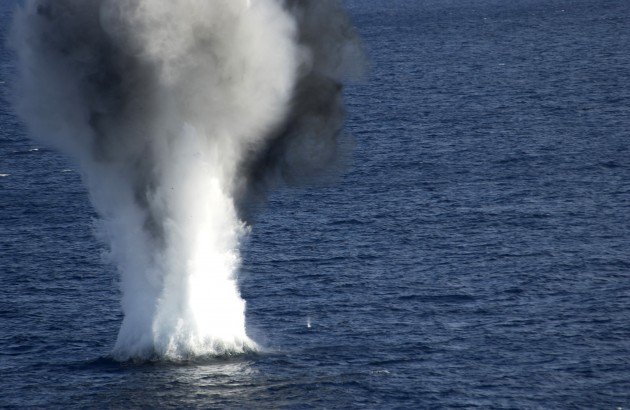
The Growing Threat to Ukraine of Naval Mines in the Black Sea
Publication: Eurasia Daily Monitor Volume: 14 Issue: 104
By:

Historically, naval mines played an important role in maritime warfare in the Black Sea. Spurred on by lessons learned during World War I and World War II, the Soviet Black Sea Fleet deployed considerable numbers of offensive and defensive mines in the Black Sea littoral waters, particularly in the northwestern portion of this body of water (Krimea.info, August 11, 2012; Topwar.ru, September 5, 2016). The northwestern sector of the Black Sea is economically important: its waters are crisscrossed by dense maritime shipping lanes, and it features several important Black Sea ports—Odesa (Ukraine), Constanza (Romania), Varna and Burgas (Bulgaria)—as well as the mouths of key water arteries (the Danube, Dnieper, Dniester and the Southern Bug) and a number of relatively large bays. At the same time, this maritime area is relatively shallow, with a depth of less than 100 meters from the Crimean Cape of Tarkhankut to the mouth of the Danube River and only a few dozen meters for a 30-kilometer stretch along the Romanian and Bulgarian coasts (Lib.rus.ec, October 24, 2010). This section of the Black Sea is also frequently beset by foggy weather. Together, such conditions make this area particularly favorable for stealthy mine laying operations (Collectedpapers.com.ua, accessed August 3), while at the same time impeding mine countermeasures (MCM) activities. Hence, naval mines were widely used in the northwestern part of the Black Sea in war time to blockade ports (naval bases) as well as to threaten coastal maritime communications. Unexploded WWI and WWII–era naval mines still lay at the bottom of the Black Sea to this day, threatening local shipping (Sevastopolnews.info, June 6).
The Russian Black Sea Fleet has accumulated considerable experience in mine warfare in the region. This fleet has traditionally been the Navy’s leader when it comes to its ability to lay multiple large minefields (Vpk-news.ru, September 16, 2015). The Black Sea Fleet’s minesweepers and landing ships as well as maritime aviation are able to lay more than 1,000 naval mines at once. This fleet is equipped with 500–1,500-kilogram anchor and bottom mines, equipped with combined fuses, which can be used by aircraft, surface ships and submarines. Among the modern types are MDM-1 and MDM-3 mines, which weigh about a ton (Nezavisimaya Gazeta, June 23). The depth of their setting can reach 120 meters and the radius of the affected zone—up to 50–70 meters. A significant number of traditional anchor mines (mostly non-contact mines), including deep-sea mines, can be used at depths up to 1,500 meters. The Russian arsenal also includes a considerable number of RM-1 and PM-2 reactive-emerging mines. The most modern model is the anti-submarine complex PMK-2. Russia increased the production of naval mines after illegally annexing Crimea. And recently, it has improved and upgraded its scientific-industrial facilities for naval mine modernization/construction (Mosreg.ru, July 21).
Naval mines, weapons characterized by great destructive power and cost-effectiveness, are particularly difficult to detect and neutralize. As such, they have a powerful psychological effect. Minefields to blockade particular sea areas, naval bases or ports can be installed densely (whereby the probability of detonation is 0.6–0.8) or sparsely (with probability of detonation being 0.1–0.3). Even a single naval mine could be used in order to pose a threat to freedom of navigation in an area where merchant shipping is particularly heavy. The operational size of the northwestern part of the Black Sea is such that were a mine to suddenly explode beneath the hull of one or two commercial vessels, this would likely entirely hinder further maritime navigation in the area until adequate counter-measures could be taken—negatively affecting the economies of the regional littoral states. The Crimean annexation underscored that the element of surprise, stealthiness and maskirovka are key elements of Russia’s so-called “New Type of Warfare.” Therefore, it would not be outside the realm of possibility for Russia to carry out concealed offensive mine activities in the northwestern part of the Black Sea. At the same time, the probability of more intensive and more overt mine warfare in the Black Sea also cannot be excluded.
Taking this regional mine threat into consideration, relevant naval capabilities for systematic and “on-call” MCM operations in the Black Sea are needed by the littoral states. These threats are common to the Black Sea members of the North Atlantic Treaty Organization (NATO) as well as Ukraine. Thus, it would make sense to create an international naval group for MCM operations in the northwestern Black Sea, for example. For now, however, local MCM forces and capabilities are quite limited. In this situation, the rotational presence in the Black Sea by the Standing NATO Mine Countermeasures Group 2 (SNMCMG2), amplified by Bulgarian, Romanian, Turkish and Ukrainian assets, could be one possible solution. SNMCMG2 activities in the Black Sea would be exclusively defensive in nature, aimed at ensuring freedom of navigation and positively influencing the security of merchant shipping in the Eastern Mediterranean. Regional maritime security would only benefit from such regularized operations.



